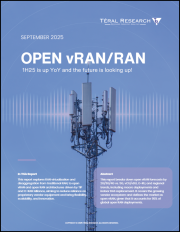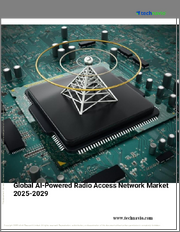
|
시장보고서
상품코드
1483063
세계의 RAN 지능형 컨트롤러 시장(2024-2031년)Global RAN Intelligent Controller Market 2024-2031 |
||||||
RAN 지능형 컨트롤러 시장은 예측 기간(2024-2031년)에 CAGR 16.5%로 성장할 것으로 예측됩니다. 시장 성장의 배경에는 실시간 분석을 제공하기 위한 인공지능(AI) 및 머신러닝(ML) 기반 시스템의 채택이 증가할 수 있습니다. RAN 지능형 컨트롤러에는 모바일 트랜스포터 비용 절감, 네트워크 제어 강화, 네트워크 성능 향상 등이 포함됩니다. RAN 지능형 컨트롤러 이용 사례로는 리소스 최적화, 트래픽 조향, 체감 품질(QoE), 서비스 품질(QoS) 최적화 등이 있습니다. RAN 지능형 컨트롤러(RIC)는 네트워크 성능을 관리하는 소프트웨어 용도 및 알고리즘을 최적화하도록 설계된 종합적인 자동화 플랫폼입니다.
시장 역학
RAN 지능형 컨트롤러에서 멀티 액세스 에지 컴퓨팅(MEC) 채택 확대
MEC는 서비스 및 용도을 호스팅하기 위한 분산 컴퓨팅 플랫폼을 제공합니다. 반응 시간을 줄이기 위해 셀룰러 사용자 가까이에 컨텐츠를 저장하고 처리할 수도 있습니다. 실시간 무선 액세스 네트워크(RAN) 데이터를 애플리케이션에 제공할 수도 있습니다. 소프트웨어 프로그램은 다중 액세스 에지 컴퓨팅(MEC)을 통해 로컬 컨텐츠, 서비스 컨텍스트 및 로컬 액세스 네트워크 상태에 대한 최신 정보에 액세스할 수 있습니다. 모바일 코어 네트워크는 여러 서비스를 제공하고 네트워크 에지에 머티리얼을 저장함으로써 추가 혼잡을 완화하고 지연에 민감한 로컬 애플리케이션을 효율적으로 지원할 수 있습니다.
인공지능(AI) 및 머신러닝(ML)의 통합이 진행됩니다.
AI와 머신러닝 기술은 RAN 지능형 컨트롤러에서 널리 사용됩니다. 5G와 4G에서는 이러한 기술이 다양한 네트워크 서비스에 적용됩니다. O-RAN은 모바일 네트워크, 특히 무선 액세스 네트워크(RAN)에서 개방형 아키텍처의 도입을 추진하고 있습니다. RAN 지능형 컨트롤러(RIC)는 5G RAN의 자동화 및 최적화를 위해 적극적으로 개발되었습니다. RIC 플랫폼에서 실행되는 다양한 AI 및 ML 애플리케이션을 포함한 xApp 및 rApp 에코시스템도 구축되었습니다. O-RAN에 정의된 니어 실시간 RAN 지능형 컨트롤러는 이 고성능, 전력 효율적인 시스템과 쉽게 통합할 수 있어 RAN의 자원 할당을 유연하게 제어할 수 있습니다. 이를 통해 임베디드 vCU/vDU 제어 로직은 머신러닝(ML) 및 인공지능(AI)을 활용하여 RAN 네트워크의 성능을 동적으로 최적화할 수 있습니다.
시장 세분화
세계의 RAN 지능형 컨트롤러 시장을 상세하게 분석하면 구성 요소, 기능, 기술 및 용도별로 다음과 같이 구분됩니다.
- 구성 요소에 따라 시장은 플랫폼과 서비스로 세분화됩니다.
- 기능을 기반으로 시장은 Non-RT RIC(비 실시간 RAN 지능형 컨트롤러)와 Near-RT RIC(니어 실시간 RAN 지능형 컨트롤러)로 세분화됩니다.
- 기술 기반에서는 시장이 4G와 5G로 세분화됩니다.
- 용도를 기반으로 시장은 rApps와 xApps로 세분화됩니다.
5G가 최대 부문와 예측
기술을 기반으로 세계의 RAN 지능형 컨트롤러 시장은 4G와 5G로 세분화됩니다. 이 중 5G 하위 부문이 시장의 최대 점유율을 차지할 것으로 예상됩니다. 이 부문의 성장을 지원하는 주요 요인으로는 5G의 RAN 지능형 컨트롤러 채택 확대가 포함되어 네트워크 성능 강화, 비즈니스 민첩성 향상, 모바일 사업자 인프라 및 운영 비용 절감을 실현합니다. 통신 사업자는 기본 장비 구성으로 적응성이 높은 개방형 네트워크를 구축할 수 있으며 다양한 기능을 추가하고 확장할 수 있습니다. 예를 들어, 후지쯔 주식회사는 2023년 2월, 후지쯔의 가상화 CU(vCU)와 가상화 DU(vDU)를 엔비디아의 GPU 기술과 결합한 새로운 5G vRAN 솔루션을 발표했습니다. 이 새로운 솔루션은 NTT 도코모가 추진하는 5G 오픈 RAN 에코시스템(OREC) 프로젝트의 일환으로 개발된 것으로, NTT 도코모는 새로운 솔루션의 성능 검증 및 평가 시험도 지원했습니다.
rApps 하위 부문이 큰 시장 점유율을 차지함
세계의 RAN 지능형 컨트롤러 시장은 용도별로 rApps와 xApps로 세분화됩니다. 이 중 rApps 하위 부문이 시장의 상당한 점유율을 차지할 것으로 예상됩니다. 이 부문의 성장은 비실시간 RAN 지능형 컨트롤러를 실행하기 위한 rApps 소프트웨어 용도의 채택이 확대되고 있기 때문입니다. rApp은 R1 인터페이스를 통해 Non-RT RIC에서 사용 가능한 기능을 활용하여 자율적인 네트워크 관리 및 최적화와 관련된 이용 사례를 충족할 수 있습니다. rApp은 Non-RT RIC의 기능을 활용하여 네트워크 데이터 및 토폴로지 검색 및 중재, 네트워크 데이터 읽기 및 쓰기, 인사이트 생성 및 고급 머신러닝 모델을 실행합니다. rApp은 비즈니스 로직에 집중하여 자동화된 이용 사례를 보다 신속하게 작성할 수 있습니다.
지역별 전망
세계의 RAN 지능형 컨트롤러 시장은 북미(미국, 캐나다), 유럽(영국, 이탈리아, 스페인, 독일, 프랑스 및 기타 유럽), 아시아태평양(인도, 중국, 일본, 한국, 기타 아시아 지역) 등의 세계의 다른 지역(중동 및 아프리카, 라틴아메리카)을 포함한 지역별로 더 구분됩니다.
유럽에서 RAN 지능형 컨트롤러 채택 증가
- Gov.UK에 따르면 2023년 4월 영국 정부의 야망의 일환으로 2030년까지 영국의 모바일 네트워크 트래픽의 35.0%를 개방적이고 상호 운용 가능한 RAN 아키텍처로 전송하기로 결정되었습니다.
- 2023년 9월 영국 정부는 보다 나은 모바일 서비스를 가능하게 하는 개방형 무선 액세스 네트워크(Open RAN)의 가능성을 입증하는 19개 프로젝트에 대해 8,800만 파운드(1억 900만 달러)의 자금 제공을 발표했습니다.
세계의 RAN 지능형 컨트롤러 시장 성장 : 지역별(2024-2031년)
북미가 주요 시장 점유율을 차지
북미는 RAN 지능형 컨트롤러와 관련 기술을 전문으로 하는 저명한 기술기업과 연구기관이 다수 존재하기 때문에 전 지역에서 큰 점유율을 차지하고 있습니다. 예를 들어, 2023년 4월 Ericsson과 캐나다 정부는 연구개발 센터에 4억 7,000만 캐나다 달러(3억 4,810만 달러) 이상을 투자했습니다. 이 투자는 에릭슨의 온타리오주 오타와와 퀘벡주 몬트리올 시설에서 이루어지며, 5G 어드밴스드, 6G, AI, 클라우드 RAN, 핵심 네트워크 기술의 세계 리더로서 수백 명의 고용 창출과 스킬업이 기대되고 있다 합니다. 게다가 5G의 도입이 증가하고 스마트폰의 보급이 진행되고 시장 관계자는 5G의 제공을 확대하기 위해 제휴 및 협력에 적극적으로 임하고 있습니다.
목차
제1장 보고서 개요
- 업계의 현황 분석 및 성장 잠재력의 전망
- 조사방법 및 툴
- 시장 분석
- 부문별
- 지역별
제2장 시장 개요 및 인사이트
- 조사 범위
- 애널리스트의 인사이트 및 현재 시장 동향
- 주요 조사 결과
- 추천 사항
- 결론
제3장 경쟁 구도
- 주요 기업 분석
- Dun & Bradstreet Corp.
- Cisco System Inc.
- 개요
- 재무 분석
- SWOT 분석
- 최근 동향
- Samsung Electronics Co., Ltd.
- 기업 개요
- 재무 분석
- SWOT 분석
- 최근 동향
- Telefonaktiebolaget LM Ericsso
- 개요
- 재무 분석
- SWOT 분석
- 최근 동향
- 주요 전략 분석
제4장 시장 세분화
- 세계의 RAN 지능형 컨트롤러 시장 : 컴포넌트별
- 플랫폼
- 서비스
- 세계의 RAN 지능형 컨트롤러 시장 : 기능별
- 비RT RIC(비실시간 RAN 지능형 컨트롤러)
- Near-RT RIC(니어 리얼타임 RAN 지능형 컨트롤러)
- 세계의 RAN 지능형 컨트롤러 시장 : 기술별
- 4G
- 5G
- 세계의 RAN 지능형 컨트롤러 시장 : 용도별
- rApps
- xApps
제5장 지역별 분석
- 북미
- 미국
- 캐나다
- 유럽
- 영국
- 독일
- 이탈리아
- 스페인
- 프랑스
- 기타 유럽
- 아시아태평양
- 중국
- 인도
- 일본
- 한국
- 기타 아시아태평양
- 세계 기타 지역
제6장 기업 프로파일
- Accelleran NV
- Accenture plc
- Airspan Networks Inc.
- ASOCS Ltd.
- Comba Telecom Systems Holdings Ltd.
- Corning Inc.
- Fujitsu Ltd.
- Hewlett Packard Enterprise Development LP
- Huawei Technologies Co., Ltd.
- Intel Corp.
- JMA, LLC
- Mavenir Systems, Inc.
- NEC Corp.
- Nokia Corp.
- Parallel Wireless, Inc.
- Qualcomm Inc.
- Radisys Corp.
- ZTE Corp.
RAN Intelligent Controller Market Size, Share & Trends Analysis Report by Component (Platforms and Services), by Function (Non-Real-Time-RAN Intelligent Controller and Near-Real-Time-RAN Intelligent Controller) by Technology (4G and 5G) and by End-User (rApps and xApps) Forecast Period (2024-2031)
RAN intelligent controller market is anticipated to grow at a CAGR of 16.5% during the forecast period (2024-2031). The market growth is attributed to the increasing adoption of artificial intelligence (AI) and machine learning (ML) based systems for providing real-time analytics. RAN intelligent controllers include lower costs for mobile transporters, greater network control, and increased network performance. Use cases for RAN intelligent controllers include resource optimization, traffic steering, quality-of-experience (QoE), and quality-of-service (QoS) optimization. RAN intelligent controller (RIC) is a comprehensive automation platform designed to optimize software applications and algorithms to manage network performance.
Market Dynamics
Growing Adoption of Multi-Access Edge Computing (MEC) in RAN Intelligent Controller
MEC offers a distributed computing platform for hosting services and applications. For faster reaction times, it can also store and process content near cellular users. Real-time radio access network (RAN) data can also be provided to applications. Software programs can access local content, service context, and up-to-date information on local-access network circumstances with multi-access edge computing (MEC). Mobile core networks can efficiently support local latency-sensitive applications by relieving additional congestion providing multiple services and storing material at the network edge.
Increasing Integration of Artificial intelligence (AI) and Machine learning (ML)
AI and machine learning technologies are widely used in RAN intelligent controllers. In 5G and 4G, these technologies are applied to various network services. The O-RAN is promoting the introduction of open architecture in mobile networks, particularly in the Radio Access Network (RAN). The RAN Intelligent Controller (RIC) is being actively developed for 5G RAN automation and optimization. An ecosystem of xApp/rApp, which includes a variety of AI/ML applications running on the RIC platform, is also being created. The O-RAN-defined near-real-time RAN intelligent controller can be easily integrated with this high-performance, power-efficient system, which allows for flexible control over resource allocation in the RAN. This makes it possible for the embedded vCU/vDU control logic to dynamically optimize RAN network performance through the use of machine learning (ML) and artificial intelligence (AI).
Market Segmentation
Our in-depth analysis of the global RAN intelligent controller market includes the following segments by component, function, technology, and application:
- Based on components, the market is sub-segmented into platforms and services.
- Based on function, the market is sub-segmented into Non-RT RIC (non-real-time-RAN intelligent controller) and Near-RT RIC (near-real-time-RAN intelligent controller).
- Based on technology, the market is sub-segmented into 4G and 5G.
- Based on application, the market is sub-segmented into rApps and xApps.
5G is Projected to Emerge as the Largest Segment
Based on the technology, the global RAN intelligent controller market is sub-segmented into 4G and 5G. Among these, 5G sub-segment is expected to hold the largest share of the market. The primary factor supporting the segment's growth includes the growing adoption of RAN intelligent controller in 5G to enhances network performance, boosts business agility, and lowers infrastructure and operating costs for mobile operators. Telecom providers can create an adaptable open network with a basic device configuration that can be expanded to include a wide range of features. For instance, in February 2023, Fujitsu Ltd. introduced a new 5G vRAN solution combining Fujitsu's virtualized CU (vCU) and virtualized DU (vDU) with NVIDIA's GPU technology. The new solution was developed as part of the 5G Open RAN Ecosystem (OREC) project promoted by NTT DOCOMO, which also supported performance verification and evaluation tests of the new solution.
rApps Sub-segment to Hold a Considerable Market Share
Based on application, the global RAN intelligent controller market is sub-segmented into rApps and xApps. Among these, rApps sub-segment is expected to hold a considerable share of the market. The segmental growth is attributed to the growing adoption of rApps software application to run the non-real time RAN intelligent controller. Utilizing the capabilities available by the Non-RT RIC via the R1 interface, rApp is able to fulfill use cases related to autonomous network management and optimization. The rApp makes use of the Non-RT RIC's capabilities for network data and topology discovery and mediation, network data read and write, insight production, and sophisticated machine learning model execution. The rApp can concentrate on the business logic and create automated use cases more quickly.
Regional Outlook
The global RAN intelligent controller market is further segmented based on geography including North America (the US, and Canada), Europe (UK, Italy, Spain, Germany, France, and the Rest of Europe), Asia-Pacific (India, China, Japan, South Korea, and Rest of Asia), and the Rest of the World (the Middle East & Africa, and Latin America).
Increasing Adoption of RAN Intelligent Controller in Europe
- According to the Gov.UK, in April 2023, As part of HM Government's ambition to carry 35.0% of the UK's mobile network traffic over open and interoperable RAN architectures by 2030.
- In September 2023, The UK government announced £88 million ($109 million) in funding for 19 projects to demonstrate the potential of open radio access networks (Open RAN) to enable better mobile services.
Global RAN Intelligent Controller Market Growth by Region 2024-2031
Source: OMR Analysis
North America Holds Major Market Share
Among all the regions, North America holds a significant share owing to numerous prominent technology companies and research institutions specializing in RAN intelligent controllers and related technologies in the region. For instance, in April 2023, Ericsson and the Government of Canada invested more than CAD 470 million ($348.1 million) in R&D centers. The investment, at Ericsson's Ottawa, Ontario and Montreal, Quebec facilities, is expected to create and upskill hundreds of jobs strengthening the sites as global leaders in 5G advanced, 6G, AI, cloud RAN, and core network technologies. Additionally, increasing 5G deployment, growing penetration of smartphones, and market players actively engaging in partnerships and collaborations to expand 5G offerings.
Market Players Outlook
Note: Major Players Sorted in No Particular Order.
The major companies serving the global RAN intelligent controller market include Cisco Systems, Inc., NEC Corp., Samsung Electronics Co., Ltd., Telefonaktiebolaget LM Ericsso, ZTE Corp., among others. The market players are increasingly focusing on business expansion and product development by applying strategies such as collaborations, mergers, and acquisitions to stay competitive in the market. For instance, in June 2023, Cisco and Intel collaborated on a network solution for communications service providers (CoSPs) that delivers on the O-RAN promise. To address integration challenges faced by CoSPs when deploying Open RAN network infrastructure, Cisco and Intel have combined forces to validate seamless interoperability between Intel(R) Ethernet 800 series network adapters with enhanced network timing capabilities and Cisco Nexus 93180YC-FX3 network switches.
Recent Development
- In July 2023, Rakuten Mobile, Inc. and Yokosuka Telecom Research Park Co., Ltd. opened a new RIC (RAN intelligent controller) research facility at the Yokosuka Research Park in Kanagawa Prefecture, Japan, with the aim of contributing to the further advancement of Open RAN (Radio Access Network) development.
- In February 2022, Juniper Networks(R) and Vodafone delivered a successful first-of-its-kind Open RAN RIC trial on a commercial network, Highlighting third-party apps integration. The application allows for the dynamic allocation of network resources without the need for over-provisioning all the way to specific customers, therefore improving resource management and network efficiency.
The Report Covers:
- Market value data analysis of 2023 and forecast to 2031.
- Annualized market revenues ($ million) for each market segment.
- Country-wise analysis of major geographical regions.
- Key companies operating in the global RAN intelligent controller market. based on the availability of data, information related to new product launches, and relevant news is also available in the report.
- Analysis of business strategies by identifying the key market segments positioned for strong growth in the future.
- Analysis of market-entry and market expansion strategies.
- Competitive strategies by identifying 'who-stands-where' in the market.
Table of Contents
1.Report Summary
- Current Industry Analysis and Growth Potential Outlook
- 1.1.Research Methods and Tools
- 1.2.Market Breakdown
- 1.2.1.By Segments
- 1.2.2.By Region
2.Market Overview and Insights
- 2.1.Scope of the Report
- 2.2.Analyst Insight & Current Market Trends
- 2.2.1.Key Findings
- 2.2.2.Recommendations
- 2.2.3.Conclusion
3.Competitive Landscape
- 3.1.Key Company Analysis
- 3.2.Dun & Bradstreet Corp.
- 3.3.Cisco System Inc.
- 3.3.1.Overview
- 3.3.2.Financial Analysis
- 3.3.3.SWOT Analysis
- 3.3.4.Recent Developments
- 3.4.Samsung Electronics Co., Ltd.
- 3.4.1.Overview
- 3.4.2.Financial Analysis
- 3.4.3.SWOT Analysis
- 3.4.4.Recent Developments
- 3.5.Telefonaktiebolaget LM Ericsso
- 3.5.1.Overview
- 3.5.2.Financial Analysis
- 3.5.3.SWOT Analysis
- 3.5.4.Recent Developments
- 3.6.Key Strategy Analysis
4.Market Segmentation
- 4.1.Global RAN Intelligent Controller Market by Component
- 4.1.1.Platforms
- 4.1.2.Services
- 4.2.Global RAN Intelligent Controller Market by Function
- 4.2.1.Non-RT RIC (Non-Real-Time-RAN Intelligent Controller)
- 4.2.2.Near-RT RIC (Near-Real-Time-RAN Intelligent Controller)
- 4.3.Global RAN Intelligent Controller Market by Technology
- 4.3.1.4G
- 4.3.2.5G
- 4.4.Global RAN Intelligent Controller Market by Application
- 4.4.1.rApps
- 4.4.2.xApps
5.Regional Analysis
- 5.1.North America
- 5.1.1.United States
- 5.1.2.Canada
- 5.2.Europe
- 5.2.1.UK
- 5.2.2.Germany
- 5.2.3.Italy
- 5.2.4.Spain
- 5.2.5.France
- 5.2.6.Rest of Europe
- 5.3.Asia-Pacific
- 5.3.1.China
- 5.3.2.India
- 5.3.3.Japan
- 5.3.4.South Korea
- 5.3.5.Rest of Asia-Pacific
- 5.4.Rest of the World
6.Company Profiles
- 6.1.Accelleran NV
- 6.2.Accenture plc
- 6.3.Airspan Networks Inc.
- 6.4.ASOCS Ltd.
- 6.5.Comba Telecom Systems Holdings Ltd.
- 6.6.Corning Inc.
- 6.7.Fujitsu Ltd.
- 6.8.Hewlett Packard Enterprise Development LP
- 6.9.Huawei Technologies Co., Ltd.
- 6.10.Intel Corp.
- 6.11.JMA, LLC
- 6.12.Mavenir Systems, Inc.
- 6.13.NEC Corp.
- 6.14.Nokia Corp.
- 6.15.Parallel Wireless, Inc.
- 6.16.Qualcomm Inc.
- 6.17.Radisys Corp.
- 6.18.ZTE Corp.



















